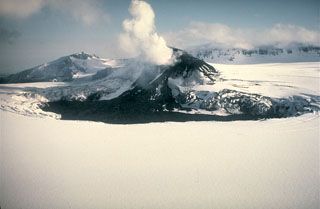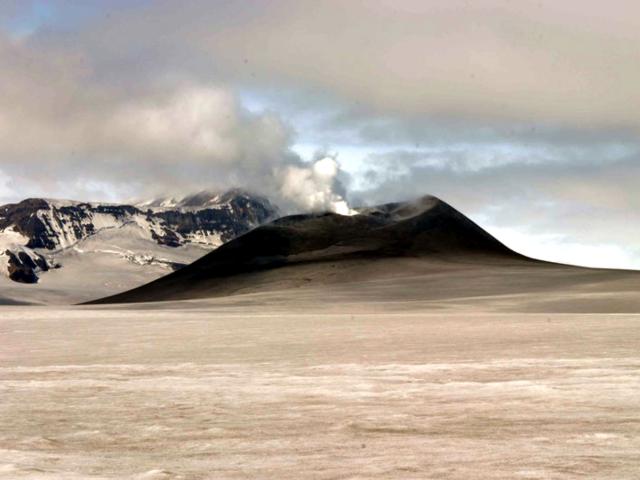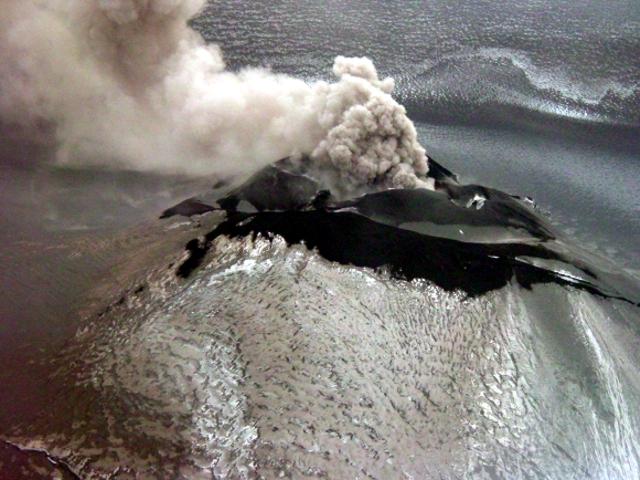Report on Veniaminof (United States) — February 2005
Bulletin of the Global Volcanism Network, vol. 30, no. 2 (February 2005)
Managing Editor: Richard Wunderman.
Veniaminof (United States) Ash emissions in January and Strombolian eruptions in February
Please cite this report as:
Global Volcanism Program, 2005. Report on Veniaminof (United States) (Wunderman, R., ed.). Bulletin of the Global Volcanism Network, 30:2. Smithsonian Institution. https://doi.org/10.5479/si.GVP.BGVN200502-312070
Veniaminof
United States
56.17°N, 159.38°W; summit elev. 2507 m
All times are local (unless otherwise noted)
After a long period of quiescence, Veniaminof began exhibiting increased seismicity and possible low-level eruptive activity from September 2002 through mid-April 2003. Between mid-April 2003 and February 2004 no signs of activity were observed. From February 2004 until the end of June 2004 steam and ash emissions were observed and volcanic tremor and earthquakes recorded (BGVN 29:06).
Activity during July 2004. Throughout July 2004 short intervals of volcanic tremor continued. Small amounts of dark ash were seen in the ice-filled caldera on 27 June. During the second week of July, the Alaska Volcano Observatory (AVO) reported that the tremor correlated well with ash-and-steam plumes as high as 1.5 km altitude; during the rest of the month, these plumes may have reached as high as 3.7 km altitude. On 22 July at 1229, an AVO field crew witnessed a small ash burst rise a few hundred meters above the summit of the intracaldera cone (figure 10). This type of activity had prevailed at Veniaminof during the previous three months. During the last week of July, the cone produced variable amounts of white steam from at least two separate craters near its top. The snow-and-ice field over much of the caldera was covered with a discontinuous, 1- to 2-mm thick ash blanket. No visual observations of ash emissions were made after 22 July, although the recorded seismicity was similar to that observed during ash emissions in the previous few months. Veniaminof remained at Concern Color Code Yellow throughout July.
Activity during August 2004. Episodes of volcanic tremor continued throughout August. No visual observations of ash emissions were made from 22 July through the first week of August, although the recorded seismicity was similar to that observed during ash emissions in the previous weeks. Throughout the month, frequent small ash-and-steam emissions from Veniaminof were visible on the web camera in Perryville and confirmed by AVO geologists working in the area. Bursts of volcanic tremor recorded intermittently on 17 August were probably associated with low-level, short-term ash emissions. Veniaminof remained at Concern Color Code Yellow throughout August 2004.
Activity during September 2004. During the first three weeks of September both low-level tremor and intermittent bursts of tremor continued at Veniaminof. AVO scientists believed tremor episodes likely represented low-level ash-and-steam emissions similar to those observed during the previous two months. Minor emissions of ash and steam were occasionally seen on the web camera during clear weather. During the last week of September, low-level tremor and intermittent small tremor bursts may have occurred at Veniaminof, but high winds in the area caused considerable vibrational noise, masking the signal of interest, and making analysis of seismic records inconclusive. The winds were strong enough to hide evidence of low-level tremor. If the tremor episodes continued, they likely corresponded with low-level ash-and-steam emissions similar to those observed over the previous four months. Cloudy conditions obscured views of the volcano by web camera and satellite. Veniaminof remained at Concern Color Code Yellow throughout September.
Activity during October 2004. Low-level seismic tremor and intermittent small tremor bursts continued. These tremor episodes likely represented low-level ash and steam emissions similar to those observed over the past four months, although cloudy conditions obscured views of the volcano by web camera and satellite. Low-level tremor during 8-15 October correlated with weak steaming of the intracaldera cone as observed on the web camera. No ash emissions were observed, although cloudy conditions over the caldera restricted viewing for much of the week. AVO lowered the Concern Color Code at Veniaminof on 26 October from Yellow to Green. Seismicity, which had been associated with ash emissions during the summer of 2004, decreased to levels that indicated ash, ash-and-steam, or steam emissions were no longer occurring on a regular basis. Since early September, no ash emissions were seen on the web camera and no evidence of ash was visible on satellite imagery. Also, AVO had received no recent reports of ash from pilots or ground observers. AVO considered the intermittent, low-level seismic tremor that continued to be recorded at the volcano to be part of the background activity.
Activity during January 2005. AVO raised the Concern Color Code at Veniaminof from Green to Yellow on 4 January because around that time several small ash emissions from the volcano's intracaldera cone were observed on the web camera in Perryville. Ash emissions were visible starting around 0938, but may have been obscured by meteorological clouds in previous images. The discrete ash emissions were small, rose hundreds of meters above the cone, and dissipated as they drifted E. Minor ash fall was probably confined to the summit caldera. Very weak seismic tremor was recorded beginning on 1 January, and increased slightly over the next 2 days. These seismic signals were similar to those recorded during steam-and-ash emissions in April to October 2004. However, there were no indications from seismic data that events significantly larger than those observed around 4 January were imminent.
AVO raised the Concern Color Code at Veniaminof from Yellow to Orange on 10 January as ash emissions from the volcano's intracaldera cone reached heights of nearly 4 km during 8-10 January (figure 11). Seismicity remained at elevated levels and satellite images showed a persistent thermal anomaly at the intracaldera cone. On 11 January, the Anchorage VAAC again reported emission of a thin ash cloud to ~ 3 km altitude visible on the Perryville web camera. On 12 January the Anchorage VAAC reported emission of a thin ash cloud, visible on the Perryville web camera, that rose to 3-4 km altitude, extended ENE, and dissipated within ~ 55 km of the volcano. On 14 January, a satellite image showed a thermal anomaly in the vicinity of the Veniaminof summit. Although the anomaly appeared less intense than when first detected on 8 January and volcanism seemed to have declined significantly since 12 January, activity still remained significantly higher than normal with occasional bursts of volcanic tremor.
During the rest of the month of January, seismic data, web camera views, and satellite images indicated that low-level ash emissions continued at Veniaminof. Seismicity was similar to levels observed during the previous week, consisting of low-amplitude volcanic tremor with occasional larger bursts. During clear weather, satellite imagery showed anomalous heat at the summit cone, consistent with hot blocks and ash being ejected from the active vent. In addition, the web camera showed intermittent ash plumes reaching as high as 3 km altitude. Occasional stronger bursts of seismic tremor during 20-21 January and around 28 January may have indicated plumes to higher levels, but not above 4 km altitude. Veniaminof remained at Concern Color Code Orange.
Activity during February 2005. On the evening of 3 February, Strombolian activity at Veniaminof was visible by residents of Perryville ~ 30 km from the volcano. Activity was also observed on web camera views and seen by satellite as an increase in radiated surface heat. An increase in seismicity suggested that Strombolian activity may have continued through 4 February while the volcano was obscured by clouds.
During 28 January to 4 February, seismicity at Veniaminof was similar to levels for the previous week, with low-amplitude tremor and occasional larger bursts. During clear weather, satellite imagery showed anomalous heat at the summit cone, consistent with hot blocks and ash being ejected from the active vent. The web camera showed intermittent ash plumes reaching as high as 3 km altitude. Veniaminof remained at Concern Color Code Orange.
Low-level Strombolian eruptive activity continued at Veniaminof during 4-11 February. On 9 February, an ash burst rose hundreds of meters above the intracaldera cone. Satellite images continued to show a thermal anomaly in the vicinity of the intracaldera cone, consistent with the presence of hot material at the vent. Seismicity remained above background levels at the volcano. On the morning of 10 February there was a distinct increase in the amplitude and frequency of earthquakes. The increase continued through 11 February. This activity was consistent with more energetic explosions from the active cone, but there were no indications that the bursts rose higher than 4 km altitude. Veniaminof remained at Concern Color Code Orange.
During 11-18 February, it was likely that low-level Strombolian eruptive activity continued at Veniaminof based on seismic data and satellite imagery. Cloudy conditions obscured web camera views of the volcano, and no ash emissions were observed above the cloud cover. Seismicity remained above background levels at Veniaminof. The character of the seismicity changed slightly during the report period, with frequent periods of continuous banded volcanic tremor occurring, but the amplitudes of earthquakes did not increase. This activity was consistent with explosions from the active cone; however, there was no indication that these bursts rose more than 4 km altitude. Veniaminof remained at Concern Color Code Orange.
Seismicity decreased substantially at Veniaminof during 18-25 February in comparison to previous weeks, leading AVO to decrease the Concern Color Code from Orange to Yellow. Periods of volcanic tremor diminished, and no discrete events associated with ash bursts had occurred for several days. Only minor steam emissions were seen. AVO received no reports of ash emissions from pilots or ground observers. AVO concluded that given the decline in seismicity, it appeared that the most recent episode of Strombolian eruptive activity at Veniaminof had ended.
Activity during March 2005. A further reduction in activity at Veniaminof during 25 February to 4 March led AVO to reduce the Concern Color Code from Yellow to Green, the lowest level. For more than a week seismic activity was at background levels, periods of volcanic tremor had ceased, and there were no discrete events associated with ash bursts. Only minor emissions of steam were observed on the web camera and satellite imagery. AVO received no reports of ash emissions from pilots or observers on the ground. They concluded that given the decline in seismicity it appeared that the most recent episode of eruptive activity had ended at Veniaminof.
Geological Summary. Veniaminof, on the Alaska Peninsula, is truncated by a steep-walled, 8 x 11 km, glacier-filled caldera that formed around 3,700 years ago. The caldera rim is up to 520 m high on the north, is deeply notched on the west by Cone Glacier, and is covered by an ice sheet on the south. Post-caldera vents are located along a NW-SE zone bisecting the caldera that extends 55 km from near the Bering Sea coast, across the caldera, and down the Pacific flank. Historical eruptions probably all originated from the westernmost and most prominent of two intra-caldera cones, which rises about 300 m above the surrounding icefield. The other cone is larger, and has a summit crater or caldera that may reach 2.5 km in diameter, but is more subdued and barely rises above the glacier surface.
Information Contacts: Alaska Volcano Observatory (AVO), a cooperative program of a) U.S. Geological Survey, 4200 University Drive, Anchorage, AK 99508-4667, USA (URL: http://www.avo.alaska.edu/), b) Geophysical Institute, University of Alaska, PO Box 757320, Fairbanks, AK 99775-7320, USA, and c) Alaska Division of Geological & Geophysical Surveys, 794 University Ave., Suite 200, Fairbanks, AK 99709, USA; Kristi L. Wallace, USGS/AVO, Alaska Tephra Laboratory and Data Center, 4230 University Drive, Suite 201, Anchorage, AK 99508, USA.



